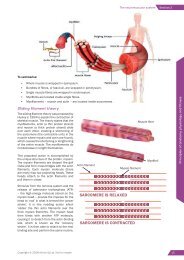Active IQ Level 2 Certificate in Promoting Community Health and Wellbeing (sample manual)
For more information, please visit http://www.activeiq.co.uk/qualifications/level-2/active-iq-level-2-certificate-in-promoting-community-health-and-well-being
For more information, please visit http://www.activeiq.co.uk/qualifications/level-2/active-iq-level-2-certificate-in-promoting-community-health-and-well-being
You also want an ePaper? Increase the reach of your titles
YUMPU automatically turns print PDFs into web optimized ePapers that Google loves.
Manual<br />
<strong>Level</strong> 2 <strong>Certificate</strong> <strong>in</strong><br />
Promot<strong>in</strong>g <strong>Community</strong><br />
<strong>Health</strong> <strong>and</strong> Wellbe<strong>in</strong>g<br />
Version A<strong>IQ</strong>004323
Figure 1.3: Determ<strong>in</strong>ants of health <strong>and</strong> well-be<strong>in</strong>g adapted from Dahlgren <strong>and</strong> Whitehead (1991).<br />
Determ<strong>in</strong>ants that have a negative impact on health<br />
There are many social <strong>and</strong> environmental risk factors <strong>and</strong> lifestyle behaviours that negatively affect health <strong>and</strong><br />
well-be<strong>in</strong>g <strong>and</strong> offer a risk to health status. Some of these are listed <strong>in</strong> table 1.2 (Labonte. 1998).<br />
Table 1.2: Risk factors <strong>and</strong> behaviours that negatively <strong>in</strong>fluence health <strong>and</strong> well-be<strong>in</strong>g<br />
Psychological Behavioural Physiological Social <strong>and</strong> Environmental<br />
Lack of social support<br />
Smok<strong>in</strong>g<br />
Altered levels<br />
of biochemical<br />
markers<br />
Poverty<br />
Isolation<br />
Physical <strong>in</strong>activity<br />
Genetics<br />
Shelter<br />
Poor social networks<br />
Substance abuse<br />
High blood<br />
pressure<br />
Low social status<br />
Pollution<br />
Low self-esteem<br />
Poor hygiene<br />
High cholesterol<br />
Natural resource<br />
depletion<br />
Low perceived power<br />
Loss of mean<strong>in</strong>g or<br />
purpose <strong>in</strong> life<br />
High self-blame<br />
Be<strong>in</strong>g overweight<br />
Unsafe sexual<br />
activity<br />
Release of stress<br />
hormones<br />
Disease <strong>and</strong><br />
chronic health<br />
conditions<br />
Discrim<strong>in</strong>ation<br />
Crime (Murder, rape, theft,<br />
property damage etc)<br />
War, riots, terrorism<br />
Abuse<br />
Poor nutritional <strong>in</strong>take<br />
Malnutrition,<br />
starvation,<br />
obesity<br />
Steep power hierarchy<br />
with<strong>in</strong> a community or<br />
workplace<br />
Copyright <strong>Active</strong> <strong>IQ</strong> Ltd. Not for resale 5
An average bottle of w<strong>in</strong>e used to be around 9% alcohol by volume (ABV) with six units <strong>in</strong> a bottle, but now<br />
it is more likely to be double that volume at around 13.5% or higher <strong>and</strong> may conta<strong>in</strong> at least ten units. The<br />
same applies to beers, lagers <strong>and</strong> ciders; the latter of which is also cheaper. The impact of this is that many<br />
people are unwitt<strong>in</strong>gly dr<strong>in</strong>k<strong>in</strong>g <strong>in</strong> excess of the recommended guidel<strong>in</strong>es <strong>and</strong> <strong>in</strong>creas<strong>in</strong>g the risk factors for<br />
their health (Lawrence <strong>and</strong> Bolitho. 2011). For example:<br />
• A p<strong>in</strong>t of high-strength lager (strength 5.2%) = 3 units.<br />
• A st<strong>and</strong>ard can of lager, beer or cider (strength 5%) = 2 units.<br />
• A st<strong>and</strong>ard glass of w<strong>in</strong>e (175ml, strength 12%) = 2 units.<br />
• A small measure (s<strong>in</strong>gle shot) of spirits (25ml, strength 40%) = 1 unit.<br />
Dr<strong>in</strong>ks of Brita<strong>in</strong><br />
Figure 2.3: Alcohol content <strong>and</strong> units <strong>in</strong> popular dr<strong>in</strong>ksUnits. They all add up.<br />
P<strong>in</strong>t cider: ABV 5.3%<br />
3 UniTs<br />
red w<strong>in</strong>e (125ML): ABV 12.5%<br />
1.6 UniTs<br />
SAMBucA Shot: ABV 42%<br />
1 UniT<br />
BottLe LAGer: ABV 5.2%<br />
1.7 UniTs<br />
ALcoPoP: ABV 5%<br />
1.4 UniTs<br />
hALf P<strong>in</strong>t cider: ABV 5.3%<br />
1.5 UniTs<br />
S<strong>in</strong>GLe G<strong>in</strong> & tonic: ABV 40%<br />
1 UniT<br />
douBLe coGnAc: ABV 40%<br />
2 UniTs<br />
chAMPAGne (175ml): ABV 11.5%<br />
2 UniTs<br />
douBLe whiSky & coke: ABV 40%<br />
2 UniTs<br />
hALf P<strong>in</strong>t LAGer: ABV 5.2%<br />
1.5 UniTs<br />
coSMoPoLitAn cocktAiL<br />
2 UniTs<br />
P<strong>in</strong>t Bitter: ABV 5%<br />
2.8 UniTs<br />
ALcoPoP: ABV 5%<br />
1.4 UniTs<br />
PiMMS: ABV 25%<br />
1.3 UniTs<br />
douBLe whiSky: ABV 40%<br />
2 UniTs<br />
Excessive <strong>in</strong>take <strong>and</strong> use of alcohol is l<strong>in</strong>ked as a contributory factor for many accident <strong>and</strong> emergency<br />
hospital admissions, a number of health conditions <strong>and</strong> other causes of morbidity, <strong>in</strong>clud<strong>in</strong>g:<br />
• cirrhosis of the liver<br />
white w<strong>in</strong>e (175ml): ABV 13%<br />
P<strong>in</strong>t LAGer: ABV 5.2%<br />
• cardiovascular disease 2.3 UniTs (coronary heart 3 UniTs disease <strong>and</strong> stroke)<br />
• weight ga<strong>in</strong><br />
• depression <strong>and</strong> anxiety<br />
• pancreatitis<br />
• osteoporosis<br />
• stomach ulcers<br />
• dementia<br />
• various cancers (mouth, throat, liver, breast)<br />
• suicide<br />
• risk of falls (<strong>in</strong> older adults)<br />
• house fires<br />
• car accidents<br />
• domestic violence<br />
• crime-related deaths (murder).<br />
BottLe of w<strong>in</strong>e: ABV 13.5%<br />
10 UniTs<br />
Copyright <strong>Active</strong> <strong>IQ</strong> Ltd. Not for resale 19
Physical activity recommendations <strong>in</strong> weight management<br />
The CMOs report ‘Start <strong>Active</strong>, Stay <strong>Active</strong>’ states that reach<strong>in</strong>g guidel<strong>in</strong>es will br<strong>in</strong>g significant health benefits<br />
for all, but for those who are overweight or obese achiev<strong>in</strong>g a healthy weight is likely to require a greater level<br />
of activity than the 150 m<strong>in</strong>utes recommended. Any programme of <strong>in</strong>crease physical activity should also be<br />
accompanied by dietary changes to reduce calorie <strong>in</strong>take.<br />
Guidel<strong>in</strong>es for early years<br />
Children under five have now been <strong>in</strong>cluded <strong>in</strong> the CMOs’ guidel<strong>in</strong>es, which reflects concern over the levels<br />
of habitual physical <strong>in</strong>activity <strong>and</strong> sedentary behaviour among young children. Key po<strong>in</strong>ts to note regard<strong>in</strong>g<br />
this group are:<br />
• Children of school age who can st<strong>and</strong> <strong>and</strong> walk need opportunities to play that will allow them to<br />
develop fundamental movement skills <strong>and</strong> master their physical environment.<br />
• Physical activity, especially <strong>in</strong> the form of play, is a basic <strong>and</strong> essential behaviour that must be encouraged<br />
<strong>in</strong> the first five years of life, while sedentary behaviours should be limited.<br />
• Children also need the freedom to create their own opportunities for active play, lead their own activities,<br />
direct their own play <strong>and</strong> engage <strong>in</strong> imag<strong>in</strong>ative play.<br />
• Physical activity ma<strong>in</strong>ly comprises unstructured, active play <strong>and</strong> learn<strong>in</strong>g locomotor, stability <strong>and</strong> objectcontrol<br />
skills.<br />
Typical activities provid<strong>in</strong>g health <strong>and</strong> developmental benefits<br />
<strong>Active</strong> play: activities that <strong>in</strong>volve movements of<br />
all major muscle groups, i.e. the legs, buttocks,<br />
shoulders <strong>and</strong> arms, <strong>and</strong> translocation of the trunk<br />
(movement of the trunk from one plane to another).<br />
Development of locomotor, stability <strong>and</strong> objectcontrol<br />
skills.<br />
Everyday activities<br />
• Climb<strong>in</strong>g frame or bike rid<strong>in</strong>g<br />
• More energetic sessions of activity, e.g. runn<strong>in</strong>g<br />
<strong>and</strong> chas<strong>in</strong>g games<br />
• Water-based activities<br />
• Runn<strong>in</strong>g, jump<strong>in</strong>g, hopp<strong>in</strong>g, gallop<strong>in</strong>g <strong>and</strong><br />
skipp<strong>in</strong>g<br />
• Balanc<strong>in</strong>g, rid<strong>in</strong>g <strong>and</strong> climb<strong>in</strong>g<br />
• Kick<strong>in</strong>g, catch<strong>in</strong>g, throw<strong>in</strong>g, strik<strong>in</strong>g <strong>and</strong> roll<strong>in</strong>g<br />
• Dance, gymnastics or water-based activities<br />
• Walk<strong>in</strong>g/skipp<strong>in</strong>g to shops, a friend’s home, a<br />
park or to <strong>and</strong> from a nursery<br />
Copyright <strong>Active</strong> <strong>IQ</strong> Ltd. Not for resale 76
The bra<strong>in</strong><br />
Cerebral cortex<br />
Processes<br />
thoughts<br />
Reduces <strong>in</strong>hibitions (<strong>in</strong>clud<strong>in</strong>g fear, a safety<br />
response).<br />
Increases self-confidence.<br />
User becomes more chatty <strong>and</strong> talkative.<br />
Affects judgement <strong>and</strong> reduces the speed at<br />
which <strong>in</strong>formation can be processed.<br />
Can affect visual <strong>and</strong> auditory senses (see<strong>in</strong>g <strong>and</strong><br />
hear<strong>in</strong>g).<br />
Numbs physical pa<strong>in</strong>.<br />
Limbic system<br />
Controls<br />
emotions <strong>and</strong><br />
memory<br />
Emotions tend to become exaggerated, i.e.<br />
everyone becomes the person’s best friend or<br />
maybe their worst enemy (aggression).<br />
Cerebellum<br />
Coord<strong>in</strong>ates<br />
body<br />
movement<br />
Movements become uncoord<strong>in</strong>ated.<br />
Balance may be affected (depend<strong>in</strong>g on the<br />
quantity of alcohol consumed, the person may<br />
be unable to st<strong>and</strong> or walk), their speech may be<br />
slurred.<br />
The heart<br />
Pumps blood<br />
around the<br />
body<br />
The blood vessels relax <strong>and</strong> dilate <strong>in</strong>creas<strong>in</strong>g<br />
blood flow to the sk<strong>in</strong> <strong>and</strong> tissues.<br />
Blood pressure lowers.<br />
Heart rate <strong>in</strong>creases to compensate for reduced<br />
blood pressure.<br />
Copyright <strong>Active</strong> <strong>IQ</strong> Ltd. Not for resale 112
Effects of Alcohol Misuse on the Body<br />
Bra<strong>in</strong><br />
Headaches, Blackouts, Delusions,<br />
Paranoia, Forgetfulness, Impaired<br />
Judgement, Decl<strong>in</strong>e <strong>in</strong> <strong>IQ</strong>, Dementia,<br />
Epilectic fits, Wernickes disease (due<br />
to vitam<strong>in</strong> deficiency), Haemorrhage,<br />
Peripheral neuritis, Korsakoff’s<br />
psychosis & Death<br />
Lungs<br />
A small amount of alcohol escapes unused<br />
via the breath 2-4%<br />
Liver<br />
Fatty cells, tissue scarr<strong>in</strong>g jaundice,<br />
hepatitis, irreversible cirrhosis- the liver<br />
breaks down 90% of alcohol consumed.<br />
Kidneys<br />
A small amount of alcohol<br />
escapes unused via ur<strong>in</strong>e<br />
2-4%<br />
Pancreas<br />
Bad digestion, malnutrition,<br />
early diabetes<br />
Sweat Gl<strong>and</strong>s<br />
A small amount of alcohol escapes unused via<br />
sweat gl<strong>and</strong>s<br />
Sex Organs<br />
Nervous System<br />
Male<br />
Depressed testicular production, impotence, breast<br />
growth due to female homones not brown down by liver<br />
Peripheral neuritis- degeneration of the<br />
nervous system supply<strong>in</strong>g limbs<br />
Throat<br />
Pressure on portal circulation- risk of<br />
haemorrage. Increased <strong>in</strong>cidence of<br />
cancer- 40x if smoker<br />
Gullet<br />
Corrosive effect- risk of cancer<br />
Intest<strong>in</strong>es<br />
Muscles<br />
Heart<br />
F<strong>in</strong>gers<br />
Nervous System<br />
Bones<br />
Degeneration, weakness, pa<strong>in</strong><br />
Weak & ‘fatty’ heart, weaken<strong>in</strong>g<br />
of heart muscles, high blood<br />
pressure. Anaemias due to<br />
decreased absorption of vitam<strong>in</strong>s<br />
Stomach<br />
Gastritis, peptic ulcer<br />
(direct corrosive effect)<br />
P<strong>in</strong>s <strong>and</strong> needles<br />
Inflammation (corrosion from alcohol)<br />
Malfunctions, shak<strong>in</strong>ess, tremors<br />
Degeneration- risk of fracture<br />
Female<br />
Failure to ovulate, spontaneous abortion<br />
Physical <strong>and</strong> emotional effects of withdraw<strong>in</strong>g from alcohol<br />
Not all dr<strong>in</strong>kers experience withdrawal symptoms when they stop us<strong>in</strong>g alcohol, but for those who do, the<br />
experience is very unpleasant. Withdrawal symptoms mostly affect people who are highly dependent on<br />
alcohol. Alcohol dependent dr<strong>in</strong>kers will sometimes have a dr<strong>in</strong>k to avoid experienc<strong>in</strong>g these symptoms,<br />
which is known as ‘relief dr<strong>in</strong>k<strong>in</strong>g’ (Alcohol Concern, 2010).<br />
Withdrawal symptoms usually commence three to six hours after the last dr<strong>in</strong>k <strong>and</strong> can last for up to a<br />
week (Davies, 2009). They are relieved when alcohol is consumed. Table 3.1 summarises the physical <strong>and</strong><br />
psychological withdrawal symptoms.<br />
Physical symptoms <strong>in</strong>clude:<br />
• headaches<br />
• nausea<br />
• vomit<strong>in</strong>g<br />
• sweat<strong>in</strong>g<br />
• h<strong>and</strong> tremors (the shakes)<br />
• convulsions (Gr<strong>and</strong> mal).<br />
Copyright <strong>Active</strong> <strong>IQ</strong> Ltd. Not for resale 121
Figure 1.2: Map of health <strong>in</strong>equalities <strong>in</strong> Engl<strong>and</strong><br />
Smok<strong>in</strong>g is more common <strong>in</strong><br />
Wales (24%) <strong>and</strong> Scotl<strong>and</strong><br />
(24%) than <strong>in</strong> Engl<strong>and</strong> (19%).<br />
Smok<strong>in</strong>g rates also vary by<br />
region <strong>in</strong> Engl<strong>and</strong>. The map of<br />
health <strong>in</strong>equalities (figure 1.2)<br />
reflects where the higher rates<br />
of premature death, l<strong>in</strong>ked<br />
to socioeconomic status <strong>and</strong><br />
<strong>in</strong>cidence of smok<strong>in</strong>g, can be<br />
found. For example, smok<strong>in</strong>g<br />
prevalence was higher <strong>in</strong><br />
Yorkshire <strong>and</strong> the North West<br />
(both 21%) than it was <strong>in</strong><br />
London (16 %).<br />
Smok<strong>in</strong>g is the lead<strong>in</strong>g cause<br />
of preventable disease <strong>and</strong><br />
premature death <strong>in</strong> the UK.<br />
Over 100,000 people die<br />
annually <strong>in</strong> Brita<strong>in</strong> as a result<br />
of smok<strong>in</strong>g. This equates to<br />
18% of all deaths <strong>in</strong> adults<br />
aged 35 <strong>and</strong> older.<br />
Revenue earned from tobacco tax<br />
In 2011-2012, the Treasury received £9.5 billion <strong>in</strong> revenue from tobacco tax (exclud<strong>in</strong>g VAT). Includ<strong>in</strong>g VAT<br />
(at an estimated £2.6 billion) total tobacco revenue was £12.1 billion. This is equivalent to around 2% of total<br />
Government revenue. The price of a pack of 20 premium br<strong>and</strong> cigarettes currently costs around £7.45, of<br />
which £5.80 (78%) is tax.<br />
Accord<strong>in</strong>g to the Office for National Statistics (ONS) ‘Consumer Trends’ report, the total UK household<br />
expenditure on tobacco has more than trebled from 1980 to 2011. In 2011 £18.3 billion was spent on<br />
tobacco. Tobacco smuggl<strong>in</strong>g costs the treasury <strong>and</strong>, although it is estimated to have dropped s<strong>in</strong>ce 2008,<br />
it is estimated that smuggl<strong>in</strong>g of illicit cigarettes accounts for 10% of the market (about £1 billion tax loss<br />
annually). Smuggl<strong>in</strong>g is far higher for h<strong>and</strong> rolled tobacco <strong>and</strong> is estimated to account for almost half of the<br />
loose tobacco smoked <strong>in</strong> the UK.<br />
Copyright <strong>Active</strong> <strong>IQ</strong> Ltd. Not for resale 144
Section 3: Key components of tobacco products <strong>and</strong> their<br />
effects on the body<br />
Substances <strong>and</strong> chemicals found <strong>in</strong> tobacco products<br />
It is frequently cited that over 4000 different chemicals are found <strong>in</strong> tobacco smoke. One research study<br />
(Rodgman <strong>and</strong> Perfetti, 2009) found 7357 chemical compounds. The content of each cigarette varies slightly<br />
by component, but there are likely to be over 7000 different chemicals <strong>in</strong> a cigarette. Of these chemicals the<br />
number quoted to be carc<strong>in</strong>ogens also varies (from 40-70) depend<strong>in</strong>g on the source of <strong>in</strong>formation.<br />
Tobacco smoke is a complex chemical system comprised of gas <strong>and</strong> particulate components, the mixture of<br />
chemicals <strong>in</strong> each phase varies accord<strong>in</strong>g to the way a cigarette is smoked. Some of the chemicals <strong>and</strong> their<br />
other uses are neatly summarised <strong>in</strong> figure 3.1.<br />
Figure 3.1: Some chemicals <strong>in</strong> tobacco smoke <strong>and</strong> their other uses<br />
Cadmium<br />
Batteries<br />
Stearic Acid<br />
C<strong>and</strong>le Wax<br />
Hexam<strong>in</strong>e<br />
Barbecue Lighter<br />
Toluene<br />
Industrial Solvent<br />
Nicot<strong>in</strong>e<br />
Insecticide<br />
Butane<br />
Lighter Fluid<br />
Ammonia<br />
Toilet Cleaner<br />
Acetone<br />
Pa<strong>in</strong>t Stripper/Nail<br />
Varnish<br />
Acetic Acid<br />
V<strong>in</strong>egar<br />
Methane<br />
Sewer Gas<br />
Arsenic<br />
Poison<br />
Carbon<br />
Monoxide<br />
Methanol<br />
Rocket Fuel<br />
Effects of nicot<strong>in</strong>e on the body<br />
Nicot<strong>in</strong>e is the ma<strong>in</strong> drug compound found <strong>in</strong> tobacco. Nicot<strong>in</strong>e is an alkaloid compound; a type of chemical<br />
often found <strong>in</strong> plants as a natural defence aga<strong>in</strong>st be<strong>in</strong>g eaten by <strong>in</strong>sects <strong>and</strong> mammals. Once <strong>in</strong> the human<br />
body, nicot<strong>in</strong>e mimics the common neurotransmitter chemical acetylchol<strong>in</strong>e giv<strong>in</strong>g it a psychoactive effect. It is<br />
this same effect which makes it highly addictive. All of the nicot<strong>in</strong>e <strong>in</strong>haled <strong>in</strong> a puff of smoke can be absorbed<br />
across the lung fluid membranes <strong>in</strong>to the blood. The nicot<strong>in</strong>e passes <strong>in</strong>to the bloodstream <strong>and</strong> reaches the<br />
bra<strong>in</strong> with<strong>in</strong> seconds of <strong>in</strong>hal<strong>in</strong>g the smoke.<br />
Copyright <strong>Active</strong> <strong>IQ</strong> Ltd. Not for resale 154

















